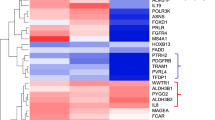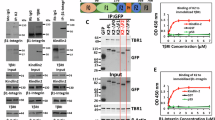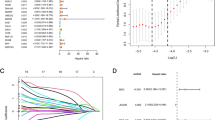Abstract
Metastasis is the leading cause of death in breast cancer patients. Osthole, as an active compound detected in the traditional Chinese medicine Wenshen Zhuanggu Formula, has shown a promising anti-metastatic activity in human breast cancer cells, but the underlying mechanisms remain ambiguous. In this study we elucidated the anti-metastatic mechanisms of osthole in highly metastatic breast cancer cells and a zebrafish xenograft model. We showed that the expression of integrin α3 (ITGα3) and integrin β5 (ITGβ5) was upregulated in highly metastatic MDA-MB-231, MDA-MB-231BO breast cancer cell lines but was downregulated in poorly metastatic MCF-7 breast cancer cell line, which might be the key targets of osthole’s anti-metastatic action. Furthermore, we showed that knockdown of ITGα3 and ITGβ5 attenuated breast cancer cell migration and invasion possibly via suppression of FAK/Src/Rac1 pathway, whereas overexpression of ITGα3 and ITGβ5 caused the opposite effects. Consistently, osthole significantly inhibited breast cancer metastasis by downregulating ITGα3/ITGβ5 signaling in vitro and in vivo. These results provide new evidence that osthole may be developed as a candidate therapeutic drug for metastatic breast cancer.
Similar content being viewed by others
Log in or create a free account to read this content
Gain free access to this article, as well as selected content from this journal and more on nature.com
or
References
Sung H, Ferlay J, Siegel RL, Laversanne M, Soerjomataram I, Jemal A, et al. Global cancer statistics 2020: GLOBOCAN estimates of incidence and mortality worldwide for 36 cancers in 185 countries. CA Cancer J Clin. 2021;71:209–49.
DeSantis CE, Ma J, Goding Sauer A, Newman LA, Jemal A. Breast cancer statistics, 2017, racial disparity in mortality by state. CA Cancer J Clin. 2017;67:439–48.
Wang S, Li GX, Tan CC, He R, Kang LJ, Lu JT, et al. FOXF2 reprograms breast cancer cells into bone metastasis seeds. Nat Commun. 2019;10:2707.
Scully OJ, Bay BH, Yip G, Yu YN. Breast cancer metastasis. Cancer Genom Proteom. 2012;9:311–20.
Kozłowski J, Kozłowska A, Kocki J. Breast cancer metastasis - insight into selected molecular mechanisms of the phenomenon. Postepy Hig Med Dosw. 2015;69:447–51.
Desgrosellier JS, Cheresh DA. Integrins in cancer: biological implications and therapeutic opportunities. Nat Rev Cancer. 2010;10:9–22.
Rivera-Nieves J, Gorfu G, Ley K. Leukocyte adhesion molecules in animal models of inflammatory bowel disease. Inflamm Bowel Dis. 2008;14:1715–35.
Gilcrease MZ. Integrin signaling in epithelial cells. Cancer Lett. 2007;247:1–25.
Givant-Horwitz V, Davidson B, Reich R. Laminin-induced signaling in tumor cells. Cancer Lett. 2005;223:1–10.
Ungewiss C, Rizvi ZH, Roybal JD, Peng DH, Gold KA, Shin DH, et al. The microRNA-200/Zeb1 axis regulates ECM-dependent β1-integrin/FAK signaling, cancer cell invasion and metastasis through CRKL. Sci Rep. 2016;6:18652.
Das V, Kalyan G, Hazra S, Pal M. Understanding the role of structural integrity and differential expression of integrin profiling to identify potential therapeutic targets in breast cancer. J Cell Physiol. 2018;233:168–85.
Huang CF, Verhulst S, Shen Y, Bu YW, Cao Y, He YC, et al. AKR1B10 promotes breast cancer metastasis through integrin α5/δ-catenin mediated FAK/Src/Rac1 signaling pathway. Oncotarget. 2016;7:43779–91.
Flamini MI, Uzair ID, Pennacchio GE, Neira FJ, Mondaca JM, Cuello-Carrión FD, et al. Thyroid hormone controls breast cancer cell movement via integrin αv/β3/SRC/FAK/PI3-kinases. Horm Cancer. 2017;8:16–27.
Tai YL, Chu PY, Lai IR, Wang MY, Tseng HY, Guan JL, et al. An EGFR/Src-dependent β4 integrin/FAK complex contributes to malignancy of breast cancer. Sci Rep. 2015;5:16408.
Li WT, Liu ZJ, Zhao CL, Zhai LM. Binding of MMP-9-degraded fibronectin to β6 integrin promotes invasion via the FAK-Src-related Erk1/2 and PI3K/Akt/Smad-1/5/8 pathways in breast cancer. Oncol Rep. 2015;34:1345–52.
Ma Y, Wang LF, Xu ZY. Research progress on traditional Chinese medicine treatment of bone metastatic cancer pain. World Sci Tech Modern Trad Chin Med Mater Med. 2018;20:468–72.
Chen J. Clinical study on the treatment of “Wenshen Zhuanggu” method for bone metastatic pain in breast cancer. Master’s dissertation, Shanghai: Shanghai University of Traditional Chinese Medicine; 2018.
Li JJ, Chen WL, Wang JY, Hu QW, Sun ZP, Zhang S, et al. Wenshen Zhuanggu Formula effectively suppresses breast cancer bone metastases in a mouse xenograft model. Acta Pharmacol Sin. 2017;38:1369–80.
Chen WL, Li JJ, Sun ZP, Wu CY, Ma J, Wang JY, et al. Comparative pharmacokinetics of six coumarins in normal and breast cancer bone-metastatic mice after oral administration of Wenshen Zhuanggu Formula. J Ethnopharmacol. 2018;224:36–44.
De Amicis F, Aquila S, Morelli C, Guido C, Santoro M, Perrotta I, et al. Bergapten drives autophagy through the up-regulation of PTEN expression in breast cancer cells. Mol Cancer. 2015;14:130.
Kleiner H, Reed M, DiGiovanni J. Naturally occurring coumarins inhibit human cytochromes P450 and block benzo[a]pyrene and 7,12-dimethylbenz[a]anthracene DNA adduct formation in MCF-7 cells. Chem Res Toxicol. 2003;16:415–22.
Wang XH, Xu CF, Hua YT, Cheng K, Zhang YZ, Liu J, et al. Psoralen induced cell cycle arrest by modulating Wnt/β-catenin pathway in breast cancer cells. Sci Rep. 2018;8:14001.
Oliveira CR, Spindola DG, Garcia DM, Erustes A, Bechara A, Palmeira-Dos-Santos C, et al. Medicinal properties of angelica archangelica root extract: cytotoxicity in breast cancer cells and its protective effects against in vivo tumor development. J Integr Med. 2019;17:132–40.
Shokoohinia Y, Jafari F, Mohammadi Z, Bazvandi L, Hosseinzadeh L, Chow N, et al. Potential anticancer properties of osthol: a comprehensive mechanistic review. Nutrients. 2018;10:36.
Park W, Park S, Song G, Lim W. Inhibitory effects of osthole on human breast cancer cell progression via induction of cell cycle arrest, mitochondrial dysfunction, and ER stress. Nutrients. 2019;11:2777.
Dai XX, Yin CT, Zhang Y, Guo GL, Zhao CG, Wang OC, et al. Osthole inhibits triple negative breast cancer cells by suppressing STAT3. J Exp Clin Cancer Res. 2018;37:322.
Yang DP, Gu TW, Wang T, Tang QJ, Ma CY. Effects of osthole on migration and invasion in breast cancer cells. Biosci Biotechnol Biochem. 2010;74:1430–4.
Hung CM, Kuo DH, Chou CH, Su YC, Ho CT, Way TD. Osthole suppresses hepatocyte growth factor (HGF)-induced epithelial-mesenchymal transition via repression of the c-Met/Akt/mTOR pathway in human breast cancer cells. J Agric Food Chem. 2011;59:9683–90.
Zhou ZY, Xiao Y, Zhao WR, Zhang J, Shi WT, Ma ZL, et al. Pro-angiogenesis effect and transcriptome profile of Shuxinyin formula in zebrafish. Phytomedicine. 2019;65:153083.
Kurozumi A, Goto Y, Matsushita R, Fukumoto I, Kato M, Nishikawa R, et al. Tumor-suppressive microRNA-223 inhibits cancer cell migration and invasion by targeting ITGA3/ITGB1 signaling in prostate cancer. Cancer Sci. 2016;107:84–94.
Hamidi H, Ivaska J. Every step of the way: integrins in cancer progression and metastasis. Nat Rev Cancer. 2018;18:533–48.
Wang JR, Liu B, Zhou L, Huang YX. MicroRNA-124-3p suppresses cell migration and invasion by targeting ITGA3 signaling in bladder cancer. Cancer Biomark. 2019;24:159–72.
Bianchi-Smiraglia A, Paesante S, Bakin AV. Integrin β5 contributes to the tumorigenic potential of breast cancer cells through the Src-FAK and MEK-ERK signaling pathways. Oncogene. 2013;32:3049–58.
Menezes JC, Diederich M. Translational role of natural coumarins and their derivatives as anticancer agents. Future Med Chem. 2019;11:1057–82.
Musa MA, Cooperwood JS, Khan MO. A review of coumarin derivatives in pharmacotherapy of breast cancer. Curr Med Chem. 2008;15:2664–79.
Saidu NE, Valente S, Bana E, Kirsch G, Bagrel D, Montenarh M. Coumarin polysulfides inhibit cell growth and induce apoptosis in HCT116 colon cancer cells. Bioorg Med Chem. 2012;20:1584–93.
Kumar M, Singla R, Dandriyal J, Jaitak V. Coumarin derivatives as anticancer agents for lung cancer therapy: a review. Anticancer Agents Med Chem. 2018;18:964–84.
Nordin N, Fadaeinasab M, Mohan S, Mohd Hashim N, Othman R, Karimian H, et al. Pulchrin A, a new natural coumarin derivative of enicosanthellum pulchrum, induces apoptosis in ovarian cancer cells via intrinsic pathway. PLoS One. 2016;11:e0154023.
Wang J, Lu ML, Dai HL, Zhang SP, Wang HX, Wei N. Esculetin. a coumarin derivative, exerts in vitro and in vivo antiproliferative activity against hepatocellular carcinoma by initiating a mitochondrial-dependent apoptosis pathway. Braz J Med Biol Res. 2015;48:245–53.
Haghighitalab A, Matin MM, Bahrami AR, Iranshahi M, Saeinasab M, Haghighi F. In vitro investigation of anticancer, cell-cycle-inhibitory, and apoptosis-inducing effects of diversin, a natural prenylated coumarin, on bladder carcinoma cells. Z Naturforsch C J Biosci. 2014;69:99–109.
Hejchman E, Taciak P, Kowalski S, Maciejewska D, Czajkowska A, Borowska J, et al. Synthesis and anticancer activity of 7-hydroxycoumarinyl gallates. Pharmacol Rep. 2015;67:236–44.
Yao F, Zhang LR, Jiang GR, Liu M, Liang GQ, Yuan Q. Osthole attenuates angiogenesis in an orthotopic mouse model of hepatocellular carcinoma via the downregulation of nuclear factor-κB and vascular endothelial growth factor. Oncol Lett. 2018;16:4471–9.
Che YL, Li J, Li ZJ, Li J, Wang S, Yan Y, et al. Osthole enhances antitumor activity and irradiation sensitivity of cervical cancer cells by suppressing ATM/NF-κB signaling. Oncol Rep. 2018;40:737–47.
Liang J, Zhou JL, Xu YQ, Huang XF, Wang XF, Huang WH, et al. Osthole inhibits ovarian carcinoma cells through LC3-mediated autophagy and GSDME-dependent pyroptosis except for apoptosis. Eur J Pharmacol. 2020;874:172990.
Kao SJ, Su JL, Chen CK, Yu MC, Bai KJ, Chang JH, et al. Osthole inhibits the invasive ability of human lung adenocarcinoma cells via suppression of NF-κB-mediated matrix metalloproteinase-9 expression. Toxicol Appl Pharmacol. 2012;261:105–15.
Wen YC, Lee WJ, Tan P, Yang SF, Hsiao M, Lee LM, et al. By inhibiting snail signaling and miR-23a-3p, osthole suppresses the EMT-mediated metastatic ability in prostate cancer. Oncotarget. 2015;6:21120–36.
Wu CY, Sun ZP, Guo BF, Ye YY, Han XH, Qin YN, et al. Osthole inhibits bone metastasis of breast cancer. Oncotarget. 2017;8:58480–93.
Shirakihara T, Kawasaki T, Fukagawa A, Semba K, Sakai R, Miyazono K, et al. Identification of integrin α3 as a molecular marker of cells undergoing epithelial-mesenchymal transition and of cancer cells with aggressive phenotypes. Cancer Sci. 2013;104:1189–97.
Zhang H, Cui XY, Cao AN, Li XL, Li LH. ITGA3 interacts with VASP to regulate stemness and epithelial-mesenchymal transition of breast cancer cells. Gene. 2020;734:144396.
Zhou B, Gibson-Corley KN, Herndon ME, Sun Y, Gustafson-Wagner E, Teoh-Fitzgerald M, et al. Integrin α3β1 can function to promote spontaneous metastasis and lung colonization of invasive breast carcinoma. Mol Cancer Res. 2014;12:143–54.
Park HJ, Helfman DM. Up-regulated fibronectin in 3D culture facilitates spreading of triple negative breast cancer cells on 2D through integrin β-5 and Src. Sci Rep. 2019;9:19950.
Gu Y, Liu YF, Fu L, Zhai LL, Zhu J, Han YM, et al. Tumor-educated B cells selectively promote breast cancer lymph node metastasis by HSPA4-targeting IgG. Nat Med. 2019;25:312–22.
Zhu C, Kong ZQ, Wang B, Cheng W, Wu AH, Meng X. ITGB3/CD61: a hub modulator and target in the tumor microenvironment. Am J Transl Res. 2019;11:7195–208.
Xu MY, Chen XH, Yin H, Yin LQ, Liu F, Fu YC, et al. Cloning and characterization of the human integrin β6 gene promoter. PLoS One. 2015;10:e0121439.
Nam EH, Lee Y, Park YK, Lee JW, Kim S. ZEB2 upregulates integrin α5 expression through cooperation with Sp1 to induce invasion during epithelial-mesenchymal transition of human cancer cells. Carcinogenesis. 2012;33:563–71.
Nam EH, Lee Y, Moon B, Lee JW, Kim S. Twist1 and AP-1 cooperatively upregulate integrin α5 expression to induce invasion and the epithelial-mesenchymal transition. Carcinogenesis. 2015;36:327–37.
Kalogeropoulou M, Voulgari A, Kostourou V, Sandaltzopoulos R, Dikstein R, Davidson I, et al. TAF4b and Jun/activating protein-1 collaborate to regulate the expression of integrin alpha6 and cancer cell migration properties. Mol Cancer Res. 2010;8:554–68.
Liu L, Mao J, Wang QF, Zhang ZW, Wu GZ, Tang QZ, et al. In vitro anticancer activities of osthole against renal cell carcinoma cells. Biomed Pharmacother. 2017;94:1020–7.
Zou TL, Wang HF, Ren T, Shao ZY, Yuan RY, Gao Y, et al. Osthole inhibits the progression of human gallbladder cancer cells through JAK/STAT3 signal pathway both in vitro and in vivo. Anticancer Drugs. 2019;30:1022–30.
Acknowledgements
This work was supported by the National Natural Science Foundation of China (Nos. 81573973 and 81774308); the Natural Science Foundation of Shanghai (No. 20ZR1458600); the Outstanding Traditional Chinese Medicine Academic Leader Program of Shanghai (No. ZY (2018-2020)-RCPY-1011).
Author information
Authors and Affiliations
Contributions
YQC, HYS, and JM conducted the main experiments; ZYZ carried out the zebrafish study; ZYL and YZ conducted the data analyses; SL provided guidance during the experiments; JYW and XHH designed the research and wrote the manuscript. All authors approved the final manuscript.
Corresponding authors
Ethics declarations
Competing interests
The authors declare no competing interests.
Supplementary information
Rights and permissions
About this article
Cite this article
Chen, Yq., Song, Hy., Zhou, Zy. et al. Osthole inhibits the migration and invasion of highly metastatic breast cancer cells by suppressing ITGα3/ITGβ5 signaling. Acta Pharmacol Sin 43, 1544–1555 (2022). https://doi.org/10.1038/s41401-021-00757-7
Received:
Accepted:
Published:
Issue date:
DOI: https://doi.org/10.1038/s41401-021-00757-7
Keywords
This article is cited by
-
Tailoring traditional Chinese medicine in cancer therapy
Molecular Cancer (2025)
-
ITGB5 is a prognostic factor in colorectal cancer and promotes cancer progression and metastasis through the Wnt signaling pathway
Scientific Reports (2025)
-
A review of the current status of biological effects of plant-derived therapeutics in breast cancer
Molecular Biology Reports (2025)
-
A secreted signature discriminates indolent from aggressive prostate tumors
World Journal of Urology (2025)
-
Anticancer potential of osthole: targeting gynecological tumors and breast cancer
Pharmacological Reports (2025)



